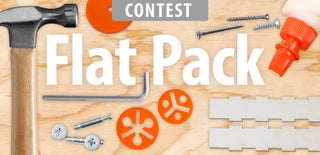Introduction: Magnetic Joinery Flat-pack Stool
Here is my take on the collapsible step stool. Firstly, I am new to the flat pack design. So new that I only started checking it out when the contest came out. I started looking into it and thought “how did I miss this”? I don’t live near an IKEA and like to buy my furniture on CL or make it. That is my summary of how this all got past me. As my mind started figuring out what it wanted me to do, I made a punch list of what it had to be:
1. 10” tall
2. 12x8” stool top
3. So easy to assemble and disassemble that a 3&5 year old boy and girl(respectivlly) could do it.
4. Be semi eye catching but not too much.
That being said. Cutting the X bottom out was easy-peasier than I expected. The plunged top stool was a little crooked(use a jig next time)but worked none the less. But it didn’t fit the 3 year old criteria yet. Why not try and lock it in place with magnets!!! This is my flash of genius. Counter sink some REM’s in the top, and set some screws in the top of the X for the magnets to lock. So there you have it in a nutshell. I worked on this for about an hour and a half for two days. Call it three hours. Take a look, enjoy, and tell me what you think. Thanks
Step 1: Out With the Old
This pic is of the old step stool I made for the kids when they were 1&3. It worked well to get them up on the counter to do all of their sink stuff. It’s gotten now where they don’t need to sit on the counter. They just need a little boost to get them up to spittin height.
Step 2: Tools and Materials
The list of tools is very basic.
Table Saw Plunge router Square Tape measurer Sand Paper Varnish Drill Gorilla Glue(for the magnets only) Parts 4 screws 4 magnets 2-12x12 pieces of ½” plywood 1-12x8 piece of ¾” plywood
Step 3: Slicing and Dicing
For the beginning layout rip down the plywood to desired size.
On the top I left a 1” overhang for looks. When all of the bottom pieces are cut to size. Lean the table swa blade over to 40 degrees. Mark out the middle of the board. Make a mark ¼” over half way to stop cutting. Run the piece into the board until you reach the stop mark. Move the fence over in 1/8” increments left and right. Keeep going and checking with the other half inch piece until the gap is enough to get your other piece thru. Repeat. Do the movements in small increments to make sure that you have a pretty tight fit but not so tight that it splinters the plywood.
Step 4: Taking the Plunge
For the plunging I borrowed a really nice plunge router with a ½” bit. I layed out the desired lines and went onwith my business. Setting the depth to 3/8”. Then I stepped it down a 1/16” allow for my magnets.
Step 5: Magnetic Joinery
For this to work out I did a little mark transposing from my plunge to the boards. The layout was not the best in the world so I would suggest that If you try this to do a little better layout work than “looks pretty dang close”.
The screws are countersunk to come out flush. The magnets are held in place with a little gorilla glue. Put something heavy on the magnets because gorilla glue expands and will mess you up!
Step 6: Voila
Well I hope that this has been an enlightening thing.
I looked up the beginnings of flat pack furniture. It kinda started with a guy who wanted to travel with a table that wouldn’t fit in his car. So he made it easily pack up. He went to work and showed it off. It was 1956, his name was Gillis Lundgren. He worked at IKEA.

Runner Up in the
Flat Pack Contest













